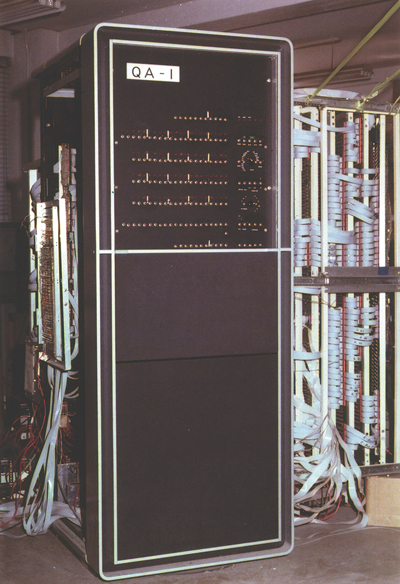

- Home >
- Artifacts of IP Heritage >
- 2013 >
- QA-1
QA-1

| Manufactured in | 1977 |
|---|---|
| Manufactured by | Faculty of Engineering, Kyoto University |
| Owner | The National Museum of Nature and Science, Tokyo |
| Location of historical materials | The National Museum of Nature and Science, Tokyo 4-1-1Amakubo, Tsukuba-shi, Ibaraki 305-0005, Japan |
| Visitor information | Not open to the public (visit by appointment only) |
| Contact | Department of Science & Engineering webmaster@kahaku.go.jp http://www.kahaku.go.jp/ |
QA-1 was developed by Hagiwara Hiroshi, Tomita Shinji, Oyanagi Shigeru, Shibayama Kiyoshi and others of Kyoto University from 1974 to 1977. Many students were also involved in developing its hardware and software. One of the objectives of the QA-1 development was to realize high speed graphical processing. QA-1 started operational in 1977 and displayed a real time animation of a butterfly flying around a flower in order to show its high-speed processing capability.
QA stands for a computer with Quadruple ALU's. It has four arithmetic and logic units (ALU's) for high speed processing of geometrical transformation using 4×4 matrices. But QA-1 is not specialized only for graphic processing. QA-1 is designed as a general purpose machine. To realize this, the system adopts 160 bit-long microinstruction that can specify four different ALU operations, four different memory accesses, and a sequential control at the same time. This architecture was named as a computer with low-level parallelism.
Main memory capacity of QA-1 is 256KB implemented with the fastest 350ns 1Kbit DRAMs that were available at that time. Microprogram control memory is 1K words of 160 bit-length implemented with TTL memory. The control memory to store microprograms adopts a virtual (cash) memory system. Microinstructions are read automatically from main memory as necessary and are executed.
The term "VLIW (Very Long Instruction Word)" was proposed by J. Fisher in 1983. Later this architecture was adopted by commercial processors such as Intel Itanium. Although QA-1 was named a computer with low-level parallelism at its developed period, QA-1 could be called as one of the pioneer VLIW computers.
QA stands for a computer with Quadruple ALU's. It has four arithmetic and logic units (ALU's) for high speed processing of geometrical transformation using 4×4 matrices. But QA-1 is not specialized only for graphic processing. QA-1 is designed as a general purpose machine. To realize this, the system adopts 160 bit-long microinstruction that can specify four different ALU operations, four different memory accesses, and a sequential control at the same time. This architecture was named as a computer with low-level parallelism.
Main memory capacity of QA-1 is 256KB implemented with the fastest 350ns 1Kbit DRAMs that were available at that time. Microprogram control memory is 1K words of 160 bit-length implemented with TTL memory. The control memory to store microprograms adopts a virtual (cash) memory system. Microinstructions are read automatically from main memory as necessary and are executed.
The term "VLIW (Very Long Instruction Word)" was proposed by J. Fisher in 1983. Later this architecture was adopted by commercial processors such as Intel Itanium. Although QA-1 was named a computer with low-level parallelism at its developed period, QA-1 could be called as one of the pioneer VLIW computers.
